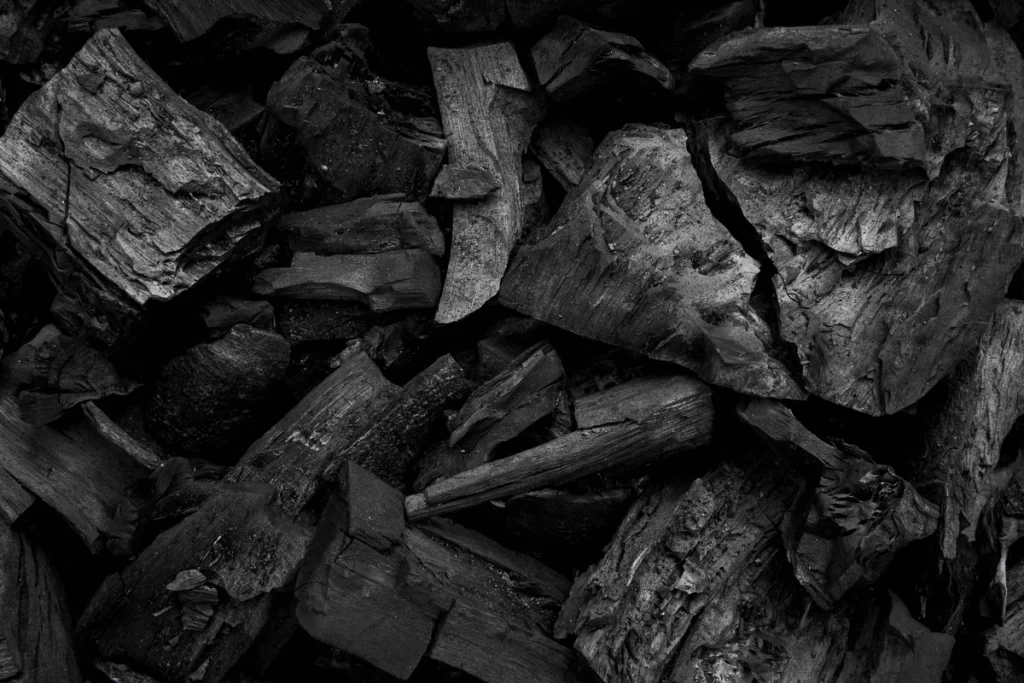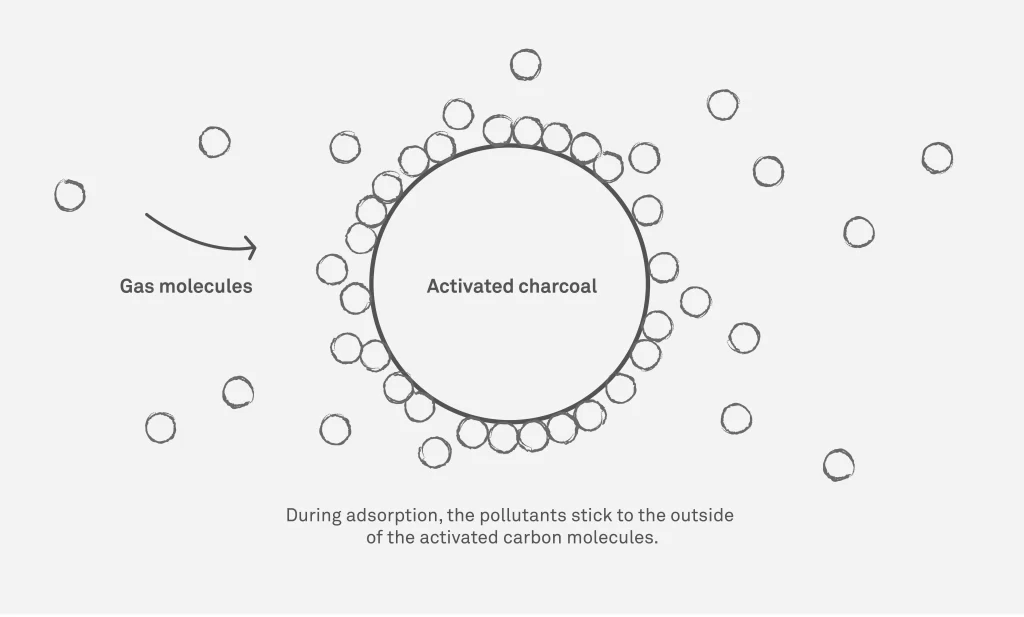

If you are looking for an activated carbon air filter to get rid of strong odors or harmful gases in your area, you have come to the right place to get all the details. Learn more about why people use carbon air purifiers, whether they work, and if you should use one to filter the air in your home.
Activated carbon has special properties that allow it to remove volatile organic compounds (VOCs), odors, and other gaseous pollutants from the air. It accomplishes this in a way that is different from other air purifiers like HEPA that only filter particle pollution from the air. Carbon air filters trap gas molecules on a bed of charcoal, a process that has a surprisingly colorful history. Here you will dive deep into how they work. Then you can consider if using a carbon air filter will meet your needs by examining its advantages and drawbacks.
Carbon air filters are the filters most commonly used to remove gases. They are designed to filter gases through a bed of activated carbon (also called activated charcoal) and are usually used to combat volatile organic compounds (VOCs) released from common household products. They are also often used to remove odors from the air, such as the smell of tobacco smoke. They cannot remove fine particles like mold, dust, or pollen from the air.
What are activated carbon air filters?

Humans have been using charcoal to purify water–sometimes accidentally–for thousands of years.
These interchangeable terms refer to the remnants of incomplete combustion. Picture the charred piece of wood that is left over after a campfire. Only the readily combustible material in the wood has burned away, either because of insufficient heat or poor supply of oxygen. The black char that remains is mostly carbon. The industrial process of making charcoal accomplishes it by heating a substance in a vacuum chamber, which releases all the volatile compounds and leaves behind all the carbon. Wood is commonly used to make charcoal, but coconut shells and coal are also used. Each substance creates a slightly different kind of charcoal.
Activated carbon is carbon that has undergone some additional processing to make it better at trapping gas molecules. First, it is injected with hot air, carbon dioxide, or steam, which creates a lattice of tiny pores in the carbon, vastly increasing its surface area. This creates many more places for molecules to become trapped and makes the carbon far more effective as a filter medium. A paper by the Ohio Environmental Protection Agency notes that a single gram of activated carbon can have hundreds of square meters of internal surface area. Most activated carbon is also treated with a chemical that enhances its ability to filter specific pollutants.
How did humans figure out that carbon can be effective at filtering contaminants? It is likely the earliest use was to remove impurities in smelted metal for the manufacture of bronze. The Egyptians appear to have been the first to use it in a medical way, to remove odors associated with infections. We know that sailors in the 16th through 18th centuries often stored their drinking water in barrels that had either been charred or smeared with charcoal on the inside to keep the water fresh on long voyages.
In World War I, gas masks utilized charcoal air filters to remove some of the deadly gases used against the troops, but it was only effective against some of the toxins. The production and use of activated carbon grew dramatically only after World War II, eventually leading to the development of modern activated carbon air filters, as well as water filters.
How do carbon air filters trap gaseous pollutants?

Activated carbon air filters remove pollutants from the air with a process known as adsorption. Note that this is different from absorption. In absorption, the substance you want to remove (let’s say water) is absorbed into the structure of the absorbent (like a sponge), but it doesn’t become a part of the absorbent on a molecular level. Therefore, when you absorb water with a sponge, the water does not become chemically bonded to the sponge. It just fills in the spaces inside it.
Carbon filters on the other hand use ad-sorption, not ab-sorption. The key difference here is that during adsorption the pollutants stick to the outside of the carbon. Whereas with absorption, the pollutants are absorbed inside the structure itself–as with the sponge.
Carbon is a lattice of carbon atoms connected to each other. The activation process is so important because the increase in surface area gives gases a greater area to stick to. When a molecule of some gaseous substance comes through the carbon, it can stick to the surface of the bed, provided there is an open adsorption site.
The process of adsorption allows carbon air filters to filter organic chemicals (gases) from the air. The problem with the activated carbon bed is that over time, the gaseous pollutants increasingly fill up the adsorption sites of the activated carbon. Once the bed is saturated, the filter can no longer trap pollutants. In fact, chemicals with a greater affinity for an adsorption site can displace those with lesser affinity, and the affinity of a given chemical for the sorbent is highly dependent on ambient conditions such as temperature and relative humidity. So, as conditions change, different chemicals may be released from the filter. When a carbon air filter is saturated, you might notice it giving off a strange odor. This is a strong indicator that it’s time to change your carbon filter.
Carbon air filters can be an important part of your area air purification system, but they have to be used correctly.
Activated carbon air filters can be helpful in a few areas.
As OSTİM Defense and Aerospace Cluster (OSSA), we held a cooperation meeting with the Ministry of National Defense General Directorate of Technical Services. The opening remarks were delivered by OSSA Chairman of the Board, Mr. İbrahim Yarsan; ASFAT General Manager, Prof. Dr. Mustafa İlbaş; and Major General Ercan Eroğlu, General Director of Technical Services at the Ministry of National Defense. Following the opening session, experts from the Ministry of National Defense delivered informative presentations on “Introduction to MoD Military Factories” and “MoD Facility Security Clearance / Production Permit Certificate Processes.” As Nero Industry, we had the opportunity to present our products and capabilities to the MoD delegation and engage in bilateral cooperation meetings throughout the program.
*Legal Notice and Intellectual Property Disclaimer:
The entire content of this website including but not limited to all textual content, graphics, logos, images, photographs, illustrations, technical and scientific drawings, audio and video clips, animations, audiovisual recordings, software, source code, databases, design elements, user interface components, and all other technical and creative materials, together with all associated intellectual and industrial property rights is the sole and exclusive property of NERO Industries Defense Inc. or its duly authorized licensors. Such content is protected under the applicable laws and regulations of the Republic of Turkey, including but not limited to the Law on Intellectual and Artistic Works (Law No. 5846), the Turkish Commercial Code, the Turkish Penal Code, as well as all relevant international treaties and conventions to which the Republic of Turkey is a party, including but not limited to the Berne Convention for the Protection of Literary and Artistic Works, the Paris Convention for the Protection of Industrial Property, the TRIPS Agreement, the WIPO Copyright Treaty, and relevant European Union Directives and Regulations, whether currently in force or entering into force in the future. Unless expressly authorized in writing by NERO Industries Defense Inc., any reproduction, modification, transmission, dissemination, republication, uploading to other platforms, storage, public display or performance, commercial exploitation, or any other form of unauthorized use, whether in whole or in part, directly or indirectly, verbatim or in altered form, of the above-mentioned materials is strictly prohibited. Furthermore, any facilitation, encouragement, or promotion of such unauthorized acts is equally prohibited. Any infringement of these rights may constitute a violation of intellectual property and/or unfair competition laws and may result in civil and/or criminal liability under applicable national and international legal frameworks.
Nero Industries develops fire suppression systems, CBRN, laser warning systems, smoke launchers and military generators as one of Turkey’s leading defense industry manufacturers.
NCAGE CODE: T9830